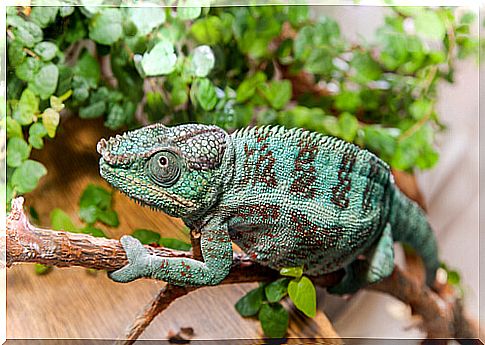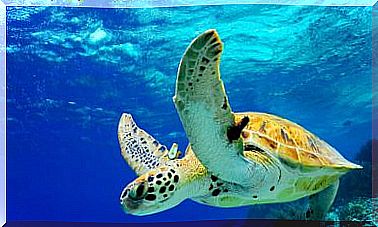Animals That Camouflage Themselves: Master Techniques

Human beings wear clothes to adapt to each situation, but other living beings have an ace up their sleeve: camouflage. In this article we will tell you about some animals that camouflage themselves and the master techniques they use. They are truly amazing!
Animals that camouflage themselves: how do they do it?
Camouflage, also called crypsis, is a phenomenon that develops in some organisms to be able to go unnoticed by other animals. This technique can be based on 4 patterns:
1. Immobility
It is the easiest way to hide from predators. Even the rate of respiration is reduced. This helps, for example, to avoid being hunted by a reptile or amphibian that does not recognize prey if they do not move. At a “higher” level, some animals simulate movements of other objects, such as a tree branch swaying in the wind.
2. Coloring
It is the most common way that animals use to hide, and it is achieved by taking the same color as the environment that surrounds it. In some cases they can change depending on the time and place (such as chameleons or cuttlefish) and, in others, they are those animals that camouflage themselves according to the time of year: the Arctic hare has a white coat in winter and brown in summer.
3. Patterns
The coat of an animal is usually related to the environment in which it develops. In this way, it can make it difficult to be seen by both prey and predators. The most prominent examples in this case are tigers and zebras. However, they cannot modify that pattern when they change ecosystems.
4. Other types of cryptos
There is also the so-called non-visual crypsis, which hinders auditory or olfactory perceptions. In the first case we can talk about the nocturnal butterflies, which emit sounds to confuse the bats. In the second, the squid that shoots ink to trick the fish.
Professional experts
Without a doubt, the chameleon is one of the animals that can best be camouflaged on the face of the earth. It has the ability to take on the color of a branch or leaf in a matter of seconds. Thanks to this assimilation of the environment, it can hunt its prey without being seen. Of course, he is not the only one among the animals that camouflage themselves. Meet the experts below:

1. Owl
Also known as an owl, this bird of prey that lives at night is covered in feathers whose hue adapts to its environment, mainly trees. Therefore they can rest on the branches without anyone being able to detect it with the naked eye.
2. Flat-tailed gecko
Or also called Madagascar, it is a reptile that lives among the trees and leaves that fall to the ground. It just looks like these because its body is brown. While it is spawning among the stones, there is nothing to indicate that there is a hidden animal there.
3. Stonefish
Animals that camouflage themselves also live in the sea. In this case, it is a fish that, in addition to being one of the most poisonous beings in the world, is also a master of the art of blending in with the environment. It can stay for hours in the same position among the rocks on the seabed. This makes it easier for you to provide yourself with food.
4. Stick insect
No one can deny that he is a professional in the art of camouflage. Its elongated and brownish body allows it to blend in with the sticks of plants and live without problems in bushes and trees. During the day they spend many hours hiding from predators. At night they mate and feed.
5. Dry leaf butterfly
When we think of a butterfly, we probably imagine a very colorful insect, however, in this case, its wings resemble the brown leaves of trees. That is its way of escaping from the beak or claws of the birds that feed on it.
6. Sepia
Again in the marine environment this animal is a cephalopod that takes the color of the place where it perches (as the chameleon does), be it sand, a rock, a coral, etc. How do they do it? Through a system in their cells that allow them to camouflage themselves in all environments.









